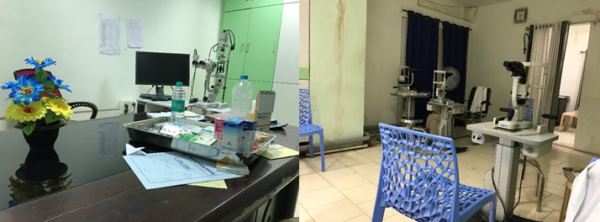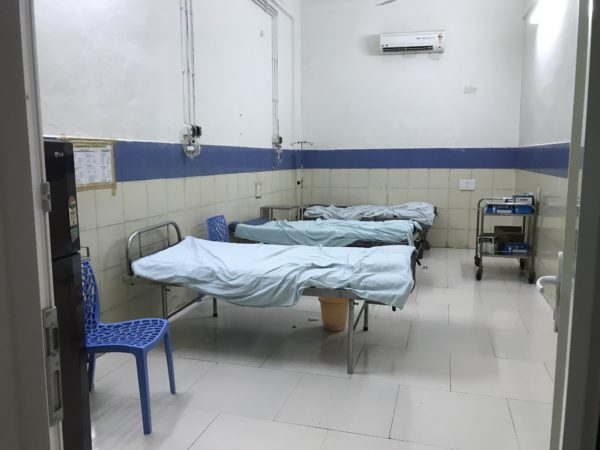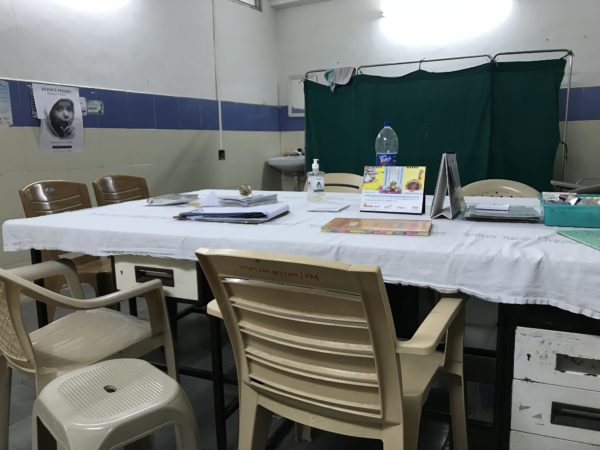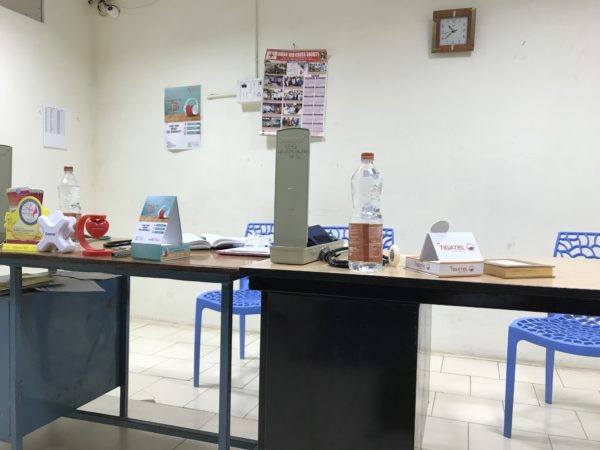Ophthalmology, General Surgery, Super Specialties
Ophthalmology
My first stop of the week was at the ophthalmology department. The ophthalmology department has been the fastest-developing department in Santhiram. It has been renovated extensively in the past few months with the addition of LASIK equipment. During my time in the outpatient room, I immediately noticed that almost all of the patients were coming in when their vision was so diminished that they could no longer function properly; discomfort in and of itself was usually not the reason for visits. Some of these patients’ vision could be improved with glasses or surgery, but some patients’ vision was diminished beyond repair. The most common conditions that these patients have are cataracts, pterygium, glaucoma, and retinal conditions. According to an ophthalmologist, an estimated ninety percent of the patients come in with diminished vision while the rest of the patients come in with headaches. When patients come into any department in the hospital with just a headache, they are usually referred to an ophthalmologist because it may be improved with glasses or general medications; if there is no improvement, then they are referred to a neurologist.
On average, throughout the year, the ophthalmologist who I was observing does thirty surgeries per day, twice a week so the doctor sees almost 200 patients every day in the OP room. This includes around 100 patients who come in for a follow-up and around 100 new patients. In March, April, May, and June, approximately 1000 surgeries are done every month; since October, the number of surgeries decreases to around 500 because there are a lot of festivals during this time.
The ophthalmology department has a separate operating theater and an anesthesia room because the risk of infection is higher for eye surgeries. Most of the surgeries that are performed are cataract surgeries. The cost of these surgeries vary based on the procedure and the quality of the lens. The two types of cataract surgeries that are frequently done are phacoemulsification and manual small-incision cataract surgery. Phacoemulsification is more costly, but it decreases the risk of complications because it allows a 6 mm lens to be placed through a 2 mm incision. However, many people who come to Santhiram choose to undergo manual small-incision cataract surgery because it is more cost-effective. After surgery, a patient is typically kept in the hospital for one day before discharge. The patient is also advised to follow-up with the doctor after one week, three weeks, and six weeks because infection risk for eye surgeries is higher than that for surgeries done on most other parts of the body.
General Surgery
After my posting in the ophthalmology department, I observed in the general surgery department. One patient especially stood out to me. This patient was admitted into the casualty because he was in so much pain. He was later diagnosed with duodenal perforation, which is basically a hole in the wall of the duodenum. A surgery was done, and I got to see the small hole that was causing such severe abdominal pain. For the surgery, lumbar spinal anesthesia and epidural were given. At times, the patient was raising his arms because the room was slightly cold and cold fluids were being sent into his body; to reduce his movements, the room and fluids were slightly warmed. I also observed in the OP; it was similar to my prior experiences in the general surgery OP, which you can read about in my previous blogs.
Super Specialties: Cardiology and Neurosurgery
Since the past few months, there have been a cardiologist and a neurosurgeon who have been working full-time in the hospital. Before then, most of the super-specialists would come in once or twice a week, partly because Santhiram is located in a rural area where patients can’t afford to pay a lot of money for treatments. For now, there are only ten to fifteen patients per day who come to see a given super-specialist. The hospital administration is currently working on setting up rooms on the top floor of the hospital along with a catheterization lab that would allow patients to be admitted into the hospital for cardiovascular diseases. Most common cardiovascular conditions include heart failure, coronary artery disease, congenital heart disease, and rheumatic heart disease; most common diagnostic tests that are given include echocardiography, ECG, angiography, and Holter monitor. Many patients who came to see the neurosurgeon had a headache, which could be a symptom of trauma, stress, migraine, sinusitis, or brain tumor. Other common neurological conditions include neck pain, tingling sensation, dizziness, vomiting, and seizures.
Look out for my blog next week because I will observing in the non-clinical Social and Preventive medicine department, which is public health oriented; I am already excited about it.









No comments.
Comments are currently closed. Comments are closed on all posts older than one year, and for those in our archive.